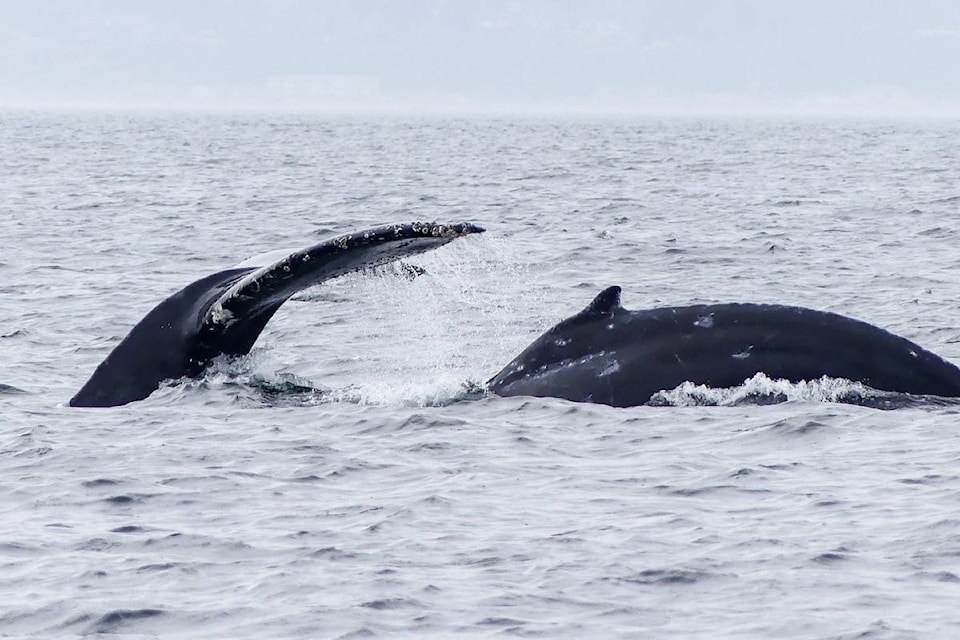The death of a juvenile humpback whale off the west coast of Vancouver Island shows the impact ship and boat collisions are having on the species, say two whale experts.
A two-year-old humpback whale was found dead near Bamfield on July 8, with propeller marks indicative of a large ship strike. The whale was first documented as a young calf in 2019 by Kaitlin Paquette, a Campbell River-based marine naturalist with Discovery Marine Safaris.
That day, Paquette was out on a rough day off Marina Island near Campbell River, and noticed a small whale next to ‘Spit Fluke’, a mature female humpback.
“I was pretty sure it was her calf by their behaviour — they were travelling close and she was matching breaths to the smaller whale, which is something the moms do,” she said.
Paquette’s discovery was confirmed by researchers, and later that summer, she photographed its tail fluke, a feature used to document and identify whales, including humpbacks. She was then given the opportunity to name the whale, and chose ‘Halfpipe’ because of a scoop-like feature on its fluke.
Learning about Halfpipe’s death was troubling for Paquette, who wants others to learn from the event how to minimize the chance of colliding with whales while boating.
RELATED: Rare whale siblings gathering in Salish Sea has researchers excited
At this time of year, whales have returned to the waters of B.C. to voraciously feed after overwintering in tropical Pacific waters, between Mexico and Hawaii. In these waters, boaters can encounter a humpback any time, so they should slow down and continually scan the horizon for whales, she explained.
“It’s really about keeping vigilant, and it’s about really educating yourself as far as what they look like,” she said. “Sometimes they’re not as visible as you would think. When they’re sleeping — which we call “logging” — they actually do look like a log, because they’re just hanging below the surface. You sometimes don’t see them until you’re really close to them.”
When a whale tour is operating near whales, they fly a whale warning flag to alert other boaters to their presence in an area. Seeing this, drivers should slow down and change course — but not all heed the warning.
“There’s nothing more frustrating when I’m out on the boat and we have the flag flying, and a boat just flies through the area,” Paquette said. “I’ve had the experience where we’ve been watching whales, and I hear on the radio five minutes later that they‘ve been hit.”
Collisions are a danger not just for whales but for boaters, too.
“If you’re in a small craft and you hit them, there’s a good chance that you may be seriously injured or even possibly killed in the process,” said Paquette.
RELATED: Marine tour operator and museum team up for historic boat tours
Knowing the frequency of these collisions is difficult, because humpbacks often die and then sink when struck, explained Jackie Hildering, humpback research and education director with the Marine Education and Research Society (MERS).
Despite this, boat and ship collisions are considered one of the primary threats to humpback whales.
Pacific humpback whales have seen a steady recovery since being protected from whaling in 1966. While this is good news for the species, many are still unaware humpbacks live off the B.C. coast for much of the year, and that the species is not just ‘passing through,’ she said.
“There is a huge gap in awareness around even the existence of humpbacks, let alone how astoundingly different they are than orcas,” she said. “How can we make the decision that we need to when we don’t understand that British Columbian waters are the staging grounds for very hungry, baleen whales back from the brink of extinction — or in some cases, still on the brink?”
MERS provides maps for boaters showing where there is an increased chance of encountering humpbacks, where extra care should be taken. But another facet of the issue is the impact of large commercial ships in open waters.
While there is a slowdown for large ships passing through killer whale critical habitat — areas also featuring abundant humpbacks — these are only voluntary, in effect for part of the year, and are for outbound traffic only, she explained.
More information is needed to determine if mandatory slowdowns or traffic diversions could be instated to help lower the risk to large whale, including humpbacks, but this could be difficult, said Hildering.
“That’s probably an idealistic step, because as soon as you slow down large vessel traffic — be they tankers, cruise ships or cargo ships — you’re impacting the economy,” she said. “But I’ve just been out there on a Coast Guard ship, and this is an obstacle course of humpbacks.”
RELATED: Climate change, urbanization and population growth threaten the Salish Sea: report
sean.feagan@campbellrivermirror.com
Like us on Facebook and follow us on Twitter
